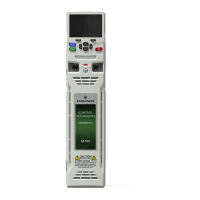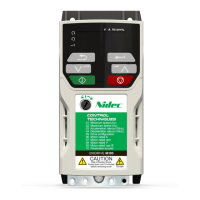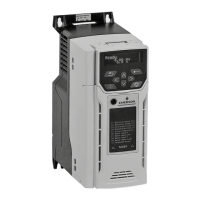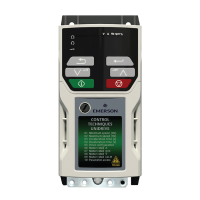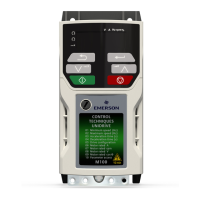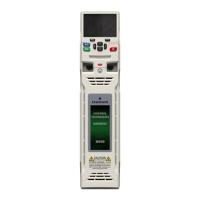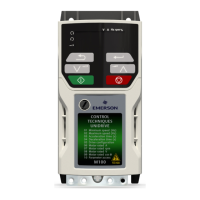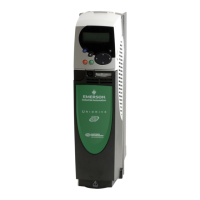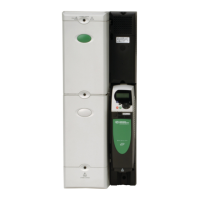Safety
information
Product
information
Mechanical
installation
Electrical
installation
Getting
started
Basic
parameters
Running
the motor
Optimization
NV Media Card
Operation
Onboard
PLC
Advanced
parameters
Technical
data
Diagnostics
UL listing
information
110 Unidrive M702 User Guide
Issue Number: 3
7.3.4 RFC-S mode (with position feedback)
Permanent magnet motor with position feedback
For simplicity only an incremental quadrature encoder with commutation outputs will be considered here. For information on setting up one of the
other supported speed feedback devices, refer to section 7.4 Setting up a feedback device on page 111.
Action Detail
Before power-
up
Ensure:
• The drive enable signal is not given (terminals 11 and 13)
• Run signal is not given
• Motor and feedback device are connected
Power-up the
drive
Verify that RFC-S mode is displayed as the drive powers up. If the mode is incorrect see section 5.6 Changing the
operating mode on page 93.
Ensure:
• Drive displays ‘inhibit’
If the drive trips, see Chapter 13 Diagnostics on page 247.
Set motor
feedback
parameters
Incremental encoder basic set-up
Enter:
• Drive encoder type in Pr. 03.038 = AB Servo (3): Quadrature encoder with commutation outputs
• Encoder power supply in Pr. 03.036 = 5 V (0), 8 V (1) or 15 V (2).
If output voltage from the encoder is >5 V, then the termination resistors must be disabled Pr 03.039 to 0.
• Drive encoder Pulses Per Revolution in Pr 03.034 (set according to encoder)
• Drive encoder termination resistor setting in Pr 03.039:
0 = A-A\, B-B\, Z-Z\ termination resistors disabled
1 = A-A\, B-B\, termination resistors enabled, Z-Z\ termination resistors disabled
2 = A-A\, B-B\, Z-Z\ termination resistors enabled
Enter motor
nameplate
details
Enter:
• Motor rated current in Pr 00.046 (A)
Ensure that this equal to or less than the Heavy Duty rating of the drive otherwise ‘Motor Too Hot’ trips may
occur during the autotune.
• Number of poles in Pr 00.042
• Motor rated voltage in Pr 00.044 (V)
Set maximum
speed
Enter:
• Maximum speed in Pr 00.002 (rpm)
Set
acceleration /
deceleration
rates
Enter:
• Acceleration rate in Pr 00.003 (s/1000 rpm)
• Deceleration rate in Pr 00.004 (s/1000 rpm) (If braking resistor installed, set Pr 00.015 = Fast. Also ensure
Pr 10.030, Pr 10.031 and Pr 10.061 are set correctly, otherwise premature ‘Brake R Too Hot’ trips may be seen).
Motor
thermistor set-
up
The motor thermistor connection is made through the drive encoder port (terminal 15). The thermistor type is selected
in P1 Thermistor Type (03.118).
Autotune
The drive is able to perform either a stationary or a rotating autotune. The motor must be at a standstill before an
autotune is enabled. A stationary autotune will give moderate performance whereas a rotating autotune will give
improved performance as it measures the actual values of the motor parameters required by the drive.The drive is
able to perform a stationary, rotating, mechanical load measurement or locked rotor test auotune. The motor must be
at a standstill before an autotune is enabled. It is suggested that a rotating auto tune is used for accurate
measurement for position feedback phase angle.
• A stationary autotune can be used when the motor is loaded and it is not possible to uncouple the load from the
motor shaft. A stationary autotune is performed to locate the flux axis of the motor. The stationary autotune
measures the stator resistance, inductance in flux axis, voltage offset at zero current, maximum voltage offset,
inductance in torque axis with no load on the motor and current at maximum voltage offset of the motor. These
are used to calculate the current loop gains, and at the end of the test the values in Pr 00.038 and Pr 00.039 are
updated. If Sensorless mode is not selected then Position Feedback Phase Angle (03.025) is set-up for the
selected position feedback.
• A rotating autotune should only be used if the motor is uncoupled. The rotating autotune will rotate the motor by
up to 2 mechanical revolutions in the direction selected, regardless of the reference provided to obtain the
position feedback phase angle. A stationary autotune is then performed to obtain stator resistance, inductance in
flux axis, voltage offset at zero current, maximum voltage offset, inductance in torque axis with no load on the
motor and current at maximum voltage offset of the motor. From the above obtained parameters the current loop
gains are calculated, and at the end of the test the values in Pr 00.038 and Pr 00.039 are updated.
Setting the encoder voltage supply too high for the encoder could result in damage to the feedback device.
Model No: 95UXXXXXXXXXXXX
Volts: 380/480
Cont: 7.7Nm:4. 81Arms
Stall: 9.5Nm:5.91Arms
Speed: 3000rpm Poles:6
Kt: 1.6Nm/Arms
Ins Class: H
Brake: 12Nm
24V
0.67A
Serial No: XXXXXXXXXXX
Control Techniques
Dynamics Ltd
ANDOVER, HANTS .
ENGLAND. SP10 5AB
The rotating autotune will rotate the motor by up to 2 mechanical revolutions in the direction selected,
regardless of the reference provided. After a short delay, the motor is further rotated through a electrical
revolution. The enable signal must be removed before the drive can be made to run at the required
reference. The drive can be stopped at any time by removing the run signal or removing the drive enable.
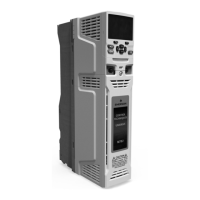
